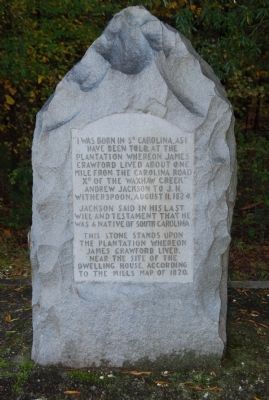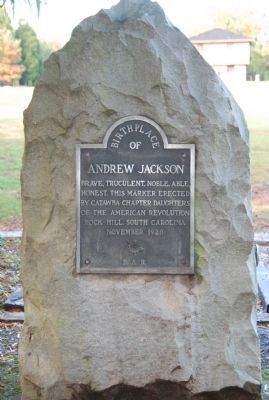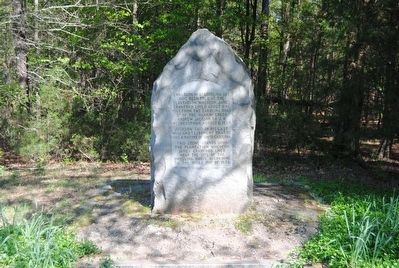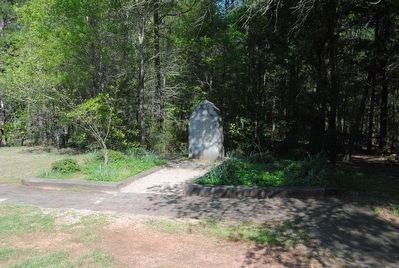Near Van Wyck in Lancaster County, South Carolina — The American South (South Atlantic)
Birthplace of Andrew Jackson Monument
Inscription.
[Carving Side]
"I was born in So Carolina, as I have been told, at the plantation whereon James Crawford lived about one mile from the Carolina Road X of the Waxhaw Creek" Andrew Jackson to J.H. Witherspoon, August 11, 1824.
Jackson said in his last will and testament that he was a native of South Carolina
This stone stands upon the plantation whereon James Crawford lived. Near the site of the dwelling house, according to the Mills map of 1820.
[Plaque Side]
Brave, truculent, noble, able, honest.
Erected 1928 by Catawba Chapter-Daughters of the American Revolution, Rock Hill, SC.
Topics and series. This historical marker and monument is listed in these topic lists: Agriculture • Settlements & Settlers. In addition, it is included in the Daughters of the American Revolution, and the Former U.S. Presidents: #07 Andrew Jackson series lists. A significant historical year for this entry is 1824.
Location. 34° 50.418′ N, 80° 48.378′ W. Marker is near Van Wyck, South Carolina, in Lancaster County. Marker is on Andrew Jackson State Park Road, 0.4 miles east of Charlotte Highway (U.S. 521). Marker is in Andrew Jackson State Park. Touch for map. Marker is in this post office area: Van Wyck SC 29744, United States of America. Touch for directions.
Other nearby markers. At least 10 other markers are within walking distance of this marker. Heart of the Community (within shouting distance of this marker); Welcome to Andrew Jackson State Park (within shouting distance of this marker); Jackson Comes Home (within shouting distance of this marker); Welcome to the Andrew Jackson State Park Museum (about 300 feet away, measured in a direct line); The Boy of the Waxhaws (about 300 feet away); School Days in the Waxhaws (about 300 feet away); Andrew Jackson State Park (approx. ¼ mile away); Birthplace of Andrew Jackson (approx. ¼ mile away); a different marker also named Birthplace of Andrew Jackson (approx. ¼ mile away); Major Crawford's Home (approx. half a mile away). Touch for a list and map of all markers in Van Wyck.
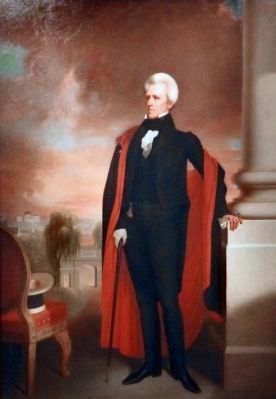
Photographed By Allen C. Browne, February 16, 2015
5. Andrew Jackson
This 1836-37 portrait of Andrew Jackson by Ralph E. W. Earl hangs in the National Portrait Gallery in Washington DC.
“With the possible exception of Abraham Lincoln, no nineteenth-century president wielded his powers more aggressively than Andrew Jackson, which is confirmed by his use of the presidential veto over Congress. Unlike his predecessors, who invoked that power on strictly constitutional grounds, Jackson vetoed key congressional measures, not because he deemed them illegal, but simply because he did not like them. In doing so, he set a precedent that vastly enlarged the presidential role in congressional lawmaking. Among Jackson's opponents, this executive activism drew charges of dictatorship. Those accusations, however, carried little weight among yeoman farmers and laborers, who doted on Jackson's professed opposition to elitism.
Jackson is here depicted in the last year of his presidency, standing on the east portico of the White House with the Capitol in the distance. In 1836 Jackson selected the plan, architects, and site for the new Patent Office Building, now the home of the National Portrait Gallery and the Smithsonian American Art Museum.” — National Portrait Gallery
“With the possible exception of Abraham Lincoln, no nineteenth-century president wielded his powers more aggressively than Andrew Jackson, which is confirmed by his use of the presidential veto over Congress. Unlike his predecessors, who invoked that power on strictly constitutional grounds, Jackson vetoed key congressional measures, not because he deemed them illegal, but simply because he did not like them. In doing so, he set a precedent that vastly enlarged the presidential role in congressional lawmaking. Among Jackson's opponents, this executive activism drew charges of dictatorship. Those accusations, however, carried little weight among yeoman farmers and laborers, who doted on Jackson's professed opposition to elitism.
Jackson is here depicted in the last year of his presidency, standing on the east portico of the White House with the Capitol in the distance. In 1836 Jackson selected the plan, architects, and site for the new Patent Office Building, now the home of the National Portrait Gallery and the Smithsonian American Art Museum.” — National Portrait Gallery
Credits. This page was last revised on December 14, 2019. It was originally submitted on October 28, 2009, by Michael Sean Nix of Spartanburg, South Carolina. This page has been viewed 2,165 times since then and 33 times this year. Photos: 1, 2. submitted on October 28, 2009, by Michael Sean Nix of Spartanburg, South Carolina. 3, 4. submitted on June 26, 2016, by Brian Scott of Anderson, South Carolina. 5. submitted on June 11, 2015, by Allen C. Browne of Silver Spring, Maryland. • Kevin W. was the editor who published this page.
